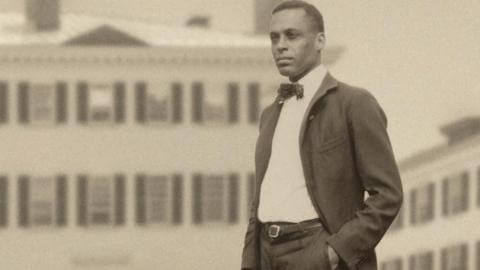A theory put forward in the 1930s by E. E. Just, embryologist and African American,
shares surprising connections with our emerging understanding of development.

Howard University was founded March 2, 1867 during the Reconstruction era after the Civil War. The departments of Botany and Zoology along with Medicine were established to represent the life sciences. The departments joined other academic units in the humanities and the social sciences during the beginning years of the university. The department of Zoology was established in 1907 with Dr. Ernest E. Just as its first Head/Chairman (1907-1938). The Botany department offered its first course in 1867 and was established as a department in 1922. Dr. Thomas W. Turner was the first Head/Chairman of the department. Initially the departments were located in the Physics building (Thirkield Hall).
In 1957 the Biology – Greenhouse building opened. It was a state-of-the-art facility designed by Dr. Marie C. Taylor (Head/Chairman – Botany department 1947-1976) and Dr. Harold E. Finley (Head/Chairman Zoology department 1947- 1969).
The academic programs of the departments offered specializations in cytology, endocrinology, embryology, genetics, parasitology, photobiology, virology, microbiology, bacteriology, immunology, plant physiology, plant populations and environment.
The Departments of Botany and Zoology both began M.S. graduate programs in 1930. The Botany M.S. program begun under the leadership of Dr. Charles Parker (Head, 1922-1947) produced nearly 300 M.S. degrees. Fifteen alumni have gone on to earn doctoral degrees in Botany (17% of all African-American Botanists), and 53 have received doctorates in other biological disciplines. The M.S. program in Zoology, established under Dr. Just, produced more than 300 graduates, many of whom have continued on to earn their Ph.D. degrees. The Ph.D. graduate program in Zoology, the third doctoral program at Howard University, was founded in 1958 under the guidance of Dr. Harold E. Finley.
The department has awarded doctoral degrees to over 125 students who represent more than 12% of the total living African-American biology PhD holders in the United States. In addition, the department represented an essential training site for students from other historically black colleges and universities that did not have doctoral programs. The Departments of Botany and Zoology, along with elements of Geology and Geography, merged to form the Department of Biology in July 1992.
Ernest Everett Just (August 14, 1883-October 27, 1941) was a pioneering African-American biologist, academic and science writer. Just’s primary legacy is his recognition of the fundamental role of the cell surface in the development of organisms. In his work within marine biology, cytology and parthenogenesis, he advocated the study of whole cells under normal conditions, rather than simply breaking them apart in a laboratory setting. Just took what seemed to be the best choice available to him and accepted a teaching position at historically black Howard University in Washington, D.C.
An African American scientist whose recognition of the fundamental role of the cell surface in the development of organisms helped pave the way to modern cell and developmental biology

A theory put forward in the 1930s by E. E. Just, embryologist and African American,
shares surprising connections with our emerging understanding of development.
Recent article by Theodore Walker published in Journal of Health Care for the Poor and Underserved | Volume 31, Number 1, February 2020 | Johns Hopkins University Press
Walker, Theodore, Jr. "Ernest Everett Just (1883–1941): Hero in Cell Biology and Evolutionary Bioethics." Journal of Health Care for the Poor and Underserved, vol. 31 no. 1, 2020, p. 4-10. Project MUSE, doi:10.1353/hpu.2020.0002.
Excerpt from publication: "Ernest Everett Just (born 1883, died 1941) taught biology in the Department of Zoology at Howard University in Washington D.C. from 1909 to 1941. Even though Just is seldom cited in biology textbooks, all of us have learned what Just first observed and described: when the fertilizing spermatozoon penetrates the egg cell surface, a "wave of negativity" radiates from the point of penetration sweeping around the egg cell surface, thereby repulsing all other sperm.1 During the 1920s and 1930s, Just was "the [original italics on the] current authority on fertilization" with a national and international reputation.2 [p.149] Just wrote more than 70 published research articles, and co-authored with Frank R. Lillie the chapter on "Fertilization" in Cowdry's 1924 influential edited volume, General Cytology: A Textbook of Cellular Structure and Function for Students of Biology and Medicine.3 Additionally, Just published two books as sole author, both in 1939: The Biology of the Cell Surface and Basic Methods for Experiments on Eggs of Marine Animals...."
Please read the entire article for more about Ernest Everett Just:
https://doi.org/10.1353/hpu.2020.0002
Ernest Everett Just (1883–1941): Hero in Cell Biology and Evolutionary Bioethics by Theodore Walker Jr.
Journal of Health Care for the Poor and Underserved, Volume 31, Number 1, February 2020, pp. 4-10 (Article) Published by Johns Hopkins University Press
DOI: https://doi.org/10.1353/hpu.2020.0002